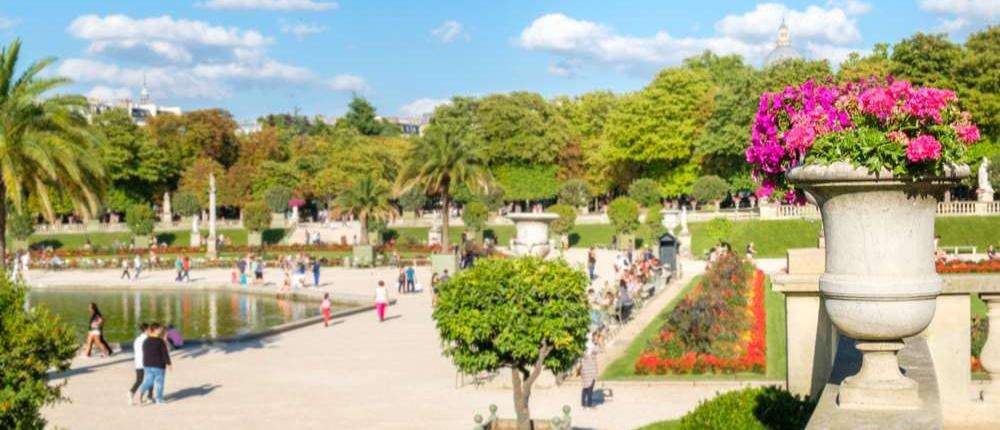The Luxembourg Gardens: one of the most beautiful in Paris
Posted in Hotel le 15 December 2023

For an outdoor picnic, for a stroll in the countryside, or to enjoy the sun comfortably seated on a lawn, the Luxembourg Gardens is the ideal green space in the heart of the 6th arrondissement of Paris. Discover the history and secrets of “Luco”, considered by tourists to be the most beautiful garden in Europe.
The history of the Luxembourg Gardens
The Luxembourg Gardens were created more than 4 centuries ago, and have since undergone numerous changes.
The origins of this Parisian garden
At the beginning of the 17th century, Marie de Medici finally realized her dream: having her own palace and floral garden. She therefore moved to the domain of the Duke of Piney-Luxembourg , in what would become the Luxembourg Gardens.
In 1612, the palace was rebuilt by the architect Salomon de Brosse and the decorator Pierre Paul Rubens, and the garden was entrusted to Jacques Boyceau, before the king's gardener, André Le Nôtre, took over in 1635.
The different developments of the landscaped garden
For many years, the Luxembourg Gardens served as a small private green space for Marie de Medici and her entourage. But, during the French Revolution, the palace of the Queen of France was requisitioned and became a prison . The garden is then abandoned. However, it was at this time that the green spaces of the property expanded by 16 hectares, thanks to the annexation of the neighboring religious convent.
Subsequently, the Luxembourg Palace served as a residence for many people, without the garden being truly maintained.
During the Second World War, the garden became the cantonment of a German regiment . Surrounded by barbed wire and occupied by bunkers, the garden serves as a parking lot for German vehicles, and the space is closed to the public.
At the end of this terrible war, the garden was liberated and became the property of the French state , which would do everything possible to restore its splendor.
The Luxembourg Gardens today
Today, the French garden in the 6th arrondissement is one of the most popular meeting places in Paris for a stroll or a well-deserved break. Between two visits to historic monuments, or after a hard day of work, green spaces now offer a peaceful and charming place, near the Bon Marché rive gauche.
Walkers meet at Boulevard Saint-Michel for a pleasant walk in the beautiful gardens decorated with sculptures and statues . They also like to relax on the famous metal chairs around the Medici fountain or along the paths of the park.
The Luxembourg Gardens is also one of the good Parisian addresses for playing sports or learning, thanks to the tennis court or the beekeeping and arboriculture courses. Finally, families like to meet there to let their children have fun in the play areas or around the large pool.
Luxembourg Gardens: practical information
The main entrance to the garden is located at 2, rue Auguste Comte , in the 6th arrondissement of Paris. You can get there in less than 20 minutes on foot from the Hôtel de l'Espérance, and in just 10 minutes by bus.
The park's opening hours change every 15 days , and adapt to the times of sunrise and sunset, with the earliest opening at 7:30 a.m. (from March to September), and the latest closing at 9:30 p.m. in June.
3 anecdotes about the Luxembourg Gardens
If the history of the Luxembourg Gardens is no secret, the Parisian green space nevertheless hides a few anecdotes.
Luco: the nickname of the landscaped garden
Parisians often like to give nicknames to different places in the capital. The Luxembourg Gardens are thus called "Luco" . This diminutive would come from the Latin word Lucotitius , which refers to the suburb of Lutèce, where the current garden is located.
A garden governed by the Senate
Most of Paris's gardens belong to the City of Paris, but not Luco! It is in fact the French Senate which owns the premises , and it is therefore this upper house of the French Parliament which manages this park.
Like any private garden, it is therefore up to the Senate to take care of the premises and their restoration.
The Luxembourg Cave: a work at the initiation of Marie de Medici
Few people know that the famous Medici fountain is an architectural work built at the request of Marie de Medici. Formerly called the Luxembourg Grotto , it was inspired by the nymphaea and fountains of the Italian gardens, the Queen's country of origin.
Over time, the fountain has undergone major changes, including its complete relocation, about thirty meters from its initial location.
Between Saint-Germain-des-Prés and the Latin Quarter, the Luxembourg Gardens is the ideal place to go green and relax in the heart of Paris. You can reach this green setting in just a few minutes from the Hôtel de l'Espérance.
